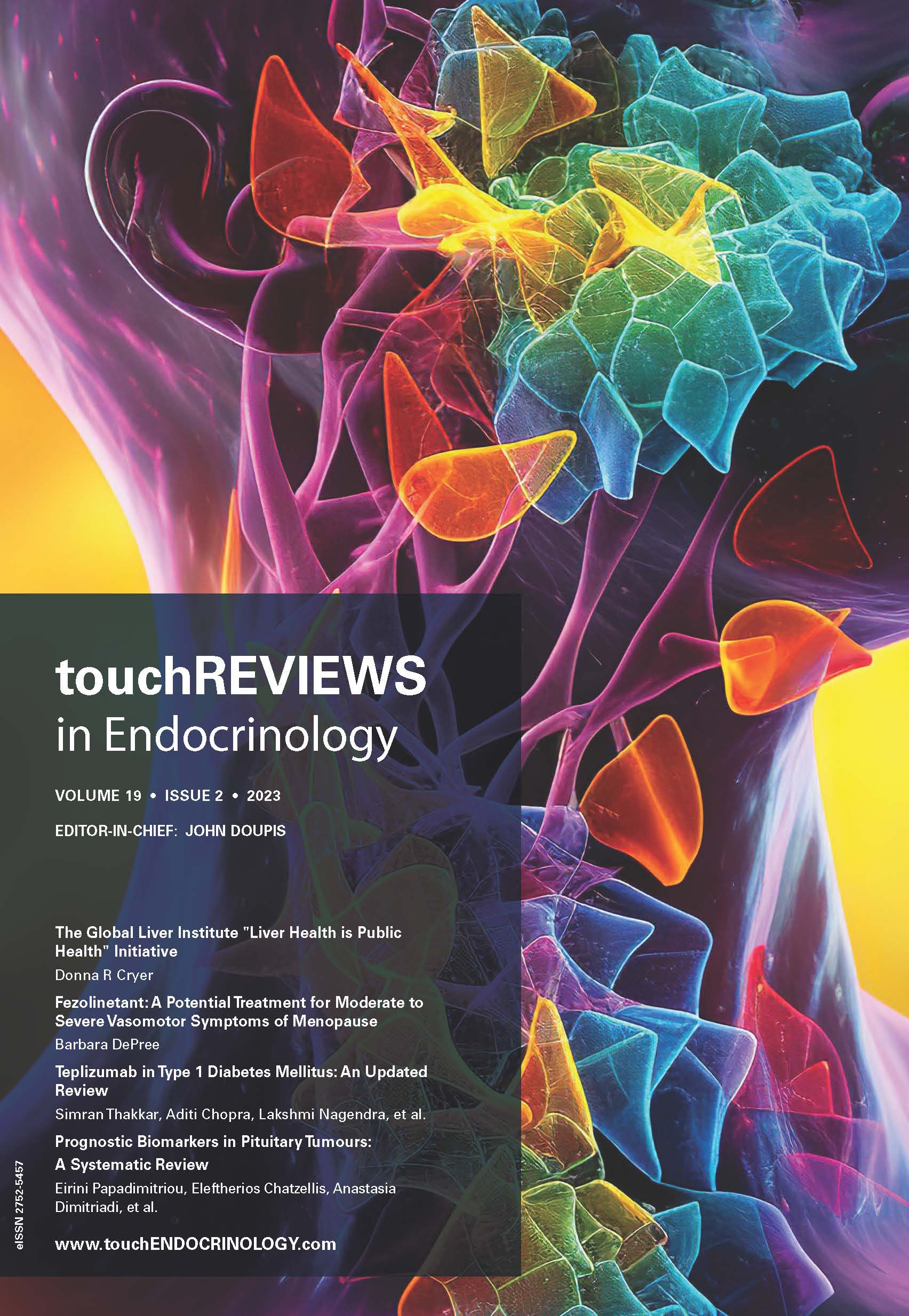European Endocrinology 15.2 – Autumn 2019
Welcome to the autumn edition of European Endocrinology!
In this issue we present authoritative, up-to-date information on a wide range of salient topics. While the global epidemic of type 2 diabetes (T2D) continues to be a major focus of clinical research, and the focus of some of the articles in this edition, we also include discussions on the relationship between obesity and secondary hypogonadism in men, and aim to highlight less common endocrine conditions.
Gezer et al. present a case of a patient with MEN1 syndrome with inoperable metastatic gastroenteropancreatic neuroendocrine tumours (GEP-NETs) who was treated with 177Lu-DOTATATE. Al-Sharefi et al. present a retrospective study examining the clinical presentation and outcomes of PHAEO/PG in NF1.
We would like to thank all expert authors who gave their time and effort to produce an insightful selection of articles and hope that you will find this edition an enjoyable and informative read.
Enjoy!
Foreword
Welcome to the autumn edition of European Endocrinology. In this issue we present authoritative, up-to-date information on a wide range of salient topics. While the global epidemic of type 2 diabetes (T2D) continues to be a major focus of clinical research, the journal also reflects the scope of the broadening discipline of endocrinology. We open with an editorial, in which Kalra et al. propose […]
Editorial
The term ‘disease progression’ is ubiquitous in clinical medicine. It has been used in various medical specialties such as oncology, nephrology, dermatology and cardiology.1–3 Type 2 diabetes (T2D), however, is a complex disease, which eludes simple definition of disease progression. The exhaustive list of pathophysiologic mechanisms that contribute to T2D is matched by an equally notable […]
Reviews
As technology has advanced over the last decade, so have the treatment options for patients with type 1 diabetes (T1D). The goal of these technological advances is improved regulation of glucose levels to more closely resemble glucose metabolism in patients without diabetes. Perhaps even more importantly, new technologies seek to improve quality of life by […]
‘Palaeolithic’ refers to the period of history of the genus Homo, beginning more than 2 million years ago when humans began to cultivate plants (predominantly cereal grains) and domesticate animals. They lived as hunter-gatherers, eating wild-animal-sourced foods (lean meats, internal organs, bone marrow, but no dairy) and uncultivated plant-sourced foods (mostly fruits, non-grain, vegetables, nuts, but […]
The global prevalence of obesity has increased tremendously in recent years. According to the World Health Organization, 39% of adults were overweight, of which 13% were obese, in 2016.1 The association between excess body weight and several medical conditions that increase morbidity and mortality is well-known. Recent clinical evidence suggests that obesity is one of the […]
Case Report
Multiple endocrine neoplasia type 1 (MEN1) is an autosomal dominant endocrine tumour syndrome characterised by three main manifestations which are primary hyperparathyroidism (78–94%), gastroenteropancreatic neuroendocrine tumours (GEP-NETs) (35–78%) and pituitary adenomas (20–65%).1 As described, GEP-NETs are the second most common component of MEN1 syndrome and metastatic GEP-NETs are shown to be related with poor prognosis.2 For […]
Original Research
Phaeochromocytomas/paragangliomas (PHAEO/PG) are chromaffin cell tumours that can present sporadically or as part of other familial syndromes including hereditary paraganglioma syndromes, multiple endocrine neoplasia 2, von Hippel-Lindau syndrome and neurofibromatosis type 1 (NF1). PHAEO/PG are found in about 0.2% of patients with hypertension1 and in 5% of all cases of adrenal incidentalomas.2,3 The vast majority of PHAEO/PG […]
Gestational diabetes mellitus (GDM) has traditionally been defined as carbohydrate intolerance, with its onset or first recognition in pregnancy.1,2 The definition, screening and diagnosis of GDM continue to be subjects of controversy.3 Recent guidelines have emphasised the importance of the definition of GDM and its distinction from overt diabetes mellitus in pregnancy, because this definition affects the […]
Globally, non-communicable diseases (NCDs) are currently the leading cause of mortality and morbidity. Of the 56.4 million global deaths in 2015, nearly 39.5 million (70%) were due to NCDs.1 Mental health disorders are one of the known major contributors to NCD burden. They are responsible for 7.4% of global disability adjusted life years (DALYs) and 22.9% […]
The growing epidemic of type 2 diabetes mellitus (T2DM) in India and the associated irreversible micro- and macro-vascular complications cause premature morbidity and mortality.1 ‘KgA1c paradox’ (Kg represents weight reduction; A1c represents glycaemic control) is now assuming significance in view of the greater tendency for Indians to develop insulin resistance, adiposity and cardiovascular diseases.2 Conventional oral antidiabetic […]

Trending Topic
We are pleased to present the latest issue of touchREVIEWS in Endocrinology, which offers a timely and thoughtprovoking collection of articles that reflect both the continuity and evolution of diabetes and metabolic disease research. In an era where technology, public health priorities and clinical paradigms are shifting rapidly, this issue highlights the importance of evidence-based […]
Journal Archive
touchREVIEWS in Endocrinology (previously European Endocrinology) is a peer-reviewed, free-to-access, bi-annual journal comprising review articles, case reports, editorials, special reports and original research. It features balanced and comprehensive articles written by leading authorities, addressing the most important and salient developments in the field of endocrinology.
Latest articles videos and clinical updates - straight to your inbox
Log into your Touch Account
Earn and track your CME credits on the go, save articles for later, and follow the latest congress coverage.
Register now for FREE Access
Register for free to hear about the latest expert-led education, peer-reviewed articles, conference highlights, and innovative CME activities.
Sign up with an Email
Or use a Social Account.
This Functionality is for
Members Only
Explore the latest in medical education and stay current in your field. Create a free account to track your learning.
















